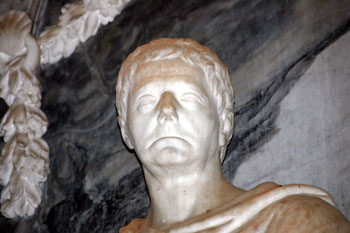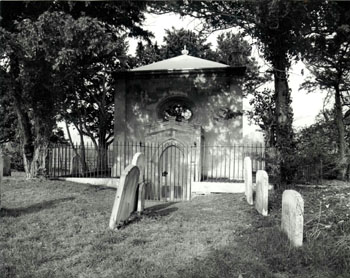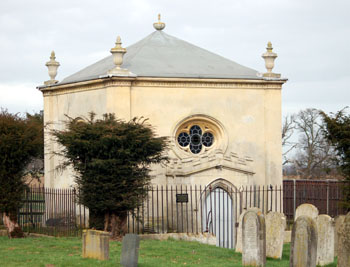The Ongley Family

Sir Samuel Ongleys monument in Old Warden church July 2007
The Ongley family first became connected with Bedfordshire in the late 17th century when Sir Samuel Ongley, a London merchant of Kentish origins, bought the Old Warden estate. Notes on the history of Old Warden [ref: CRT130WAR16] suggest that he first had connections with the county around 1690. He appears to have purchased the Old Warden Estate in 1698 from Paulet Saint John, Earl of Bolingbroke who had mortgaged them in 1693 [ref: X95/411/160]. The estate is listed as: a capital messuage or dwelling house; a newly erected farmhouse and farm; lands in occupation of Nicholas Glynister; Astons Close; Texons Close; Barkers Closes; nine cottages and all the tithes of Old Warden.
Sir Samuel is something of a mystery man, whose origins are obscure, even his will, which mentions numerous relatives, does not give much information as to their exact identity. He died unmarried in 1726, aged 80, and left his property to his nephew, another Samuel Ongley. This Samuel, like his sister, Judith, married into the Harvey family of Ickwell but as he had no children his property on his death went to his niece's third and only surviving son Robert Henley (c.1721-1785) who, in accordance with Sir Samuel's will, took the surname of Ongley.

Sir Samuel Ongley's bust from his monument, March 2008
Robert Ongley was created Baron Ongley of Old Warden; oddly this was an Irish peerage, created in this way so that he could sit in House of Commons as a member of parliament rather than having to sit in the House of Lords. By his wife, Anne, he had six children, his eldest son, Robert Henley Ongley (1771-1814), succeeding him as 2nd Baron in 1785. The 2nd Baron's eldest son was also Robert Henley Ongley (1803-1877) and became, in time, 3rd Baron. It was just after the first baron's death that the Ongley Mausoleum was built in Saint Leonard's churchyard. The structure was completed in 1787 and is built of ashlar with a leaded roof. By the time it was closed it housed the remains of ten family members, though designed for many more.
The 2nd Baron seems to have begun a policy of consolidating the family estates in Bedfordshire. He appears to have sold his London and Kent estates by about 1802. The Kent estates were sold to James Whatman. At the inclosure of Southill in 1800 he exchanged much of his property there with Samuel Whitbread to make his estates more compact around Old Warden Park and he also bought up a number of small neighbouring estates.

Ongley Mausoleum 1978 [ref: Z50/129/31]
During the 19th century the 3rd Baron began to mortgage his property. This may have been due to the need to make proper provision for his mother and sisters. His father had left £20,000 to be divided between the 3rd Baron's siblings. The 3rd Baron did not come of age, at 21, until ten years after his father's death and immediately made a grant of an annuity to his mother which had been given to her in his father's second will (which, however, because it only had two witnesses, had no legal force). The decline in the Ongley fortunes is evident from the successive mortgages recorded in the Shuttleworth archive [ref: SL]. The estates were mortgaged for £24,000 at 4% interest in 1837. In 1843, having repaid £4,000, the 3rd Baron borrowed another £5,000, borrowing a further £4,000 in 1843 and another £5,000 in 1848 - meaning he was now in debt to the tune of £38,000. Another mortgage followed in 1850, this time for £7,000 - the deed notes that the estates total income from rents was now £2,858. This means that roughly two thirds of the estate's income would now be used simply to repay the interest on the various mortgages.
 Ongley Mausoleum 1980 [ref: Z50/129/33]
Ongley Mausoleum 1980 [ref: Z50/129/33]Another snapshot of the Ongley finances comes in 1861. Rents had now risen to about £4,000 per annum and some of the mortgages had bee repaid. However, the 3rd Baron also borrowed an additional £16,000. By 1872 it was clear that the 3rd Baron would have no heirs and all his brothers had also died childless. He therefore determined to sell his estates; he had already stopped living at his mansion in Old Warden (it was let to one Henry Browning). The majority of the Bedfordshire estates (2,023 acres in Old Warden and Southill) were bought by Joseph Shuttleworth of Hartsholm Hall in Lincolnshire, for £150,000 plus around £15,000 for timber on 27th September 1872. Robert Henley, 3rd Baron Ongley died on 21st January 1877 at Teddington [Middlesex] but was buried at Old Warden in the Ongley Mausoleum. He was survived by his sister, Mrs.Frances Tucker.

Ongley Mausoleum, March 2008
The Bedfordshire Mercury of 3rd February 1877 described the funeral of the last Lord Ongley: "The deceased nobleman had for some time resided in retirement at Teddington where his death took place on Sunday, January 21st. On Monday 29th the remains were conveyed by road to Biggleswade, from which place the funeral cortege sratred on Tuesday morning. It consisted of a hearse and three coaches i nwhich were the following mourners: 1st coach, Mr.Phillimore, Mr.Burgoyne, Rev.Sanderson and Col.North; 2nd coach, Col.Walker, Mr.Turner, Sir J.Walker and Dr.Kershaw; 3rd coach, Mr.McGrath, Mr.Otley, Mr.M.Reynolds and Mr.T.Wheatley, a long and faithful servant of his lordship. The arrival at the church was fixed for half past one o'clock, and shortly after that hour the procession arrived amid a blinding shower of snow and rain, which fortunately soon passed over. A large number of the parishioners were present in the church and churchyard, and among the assemblage were the vicar of the parish, the Rev.J.G.A.Baker, and Mr.S.C.Whitbread, of Southill. The funeral service was read by the Rev.Sanderson, who taking a position at the entrance of the church, read the opening words of the service as the coffin was being conveyed up the pathway. The coffin was preceded by the Ongley coronet, borne upon a velvet cushion and also when the procession left the church, to convey the remains of the deceased nobleman to their last resting place. This was the family mausoleum, situate at the north east corner of the churchyard. It is a square stone building, lighted by windows near the roof, and a marble tablet in the interior reads attests the fact that it was "erected by Lady Ongley agreeable to the wish of Robert Henley Lord Ongley deceased MDCCLXXXVII". A flight of stone steps reached through an oaken door, leads down into the interior which is found to contain 42 compartments. Nine of thee have been used for burial, and closed with marble slabs bearing respective records of the interments. The oldest is that of Robert Henley, Lord Ongley at whose wish the mausoleum was raised; and who died in 1785, two years previous to its erection. Next is that of Frances Henley the Baronness Ongley, the lady who built the mausoleum and who died in 1799. the other inscriptions mark the interments of the Hon.Ann Henley Ongleym in 1810; Robert Henley, Lord Ongley, in 1814; Hon.Catherine Fremantle, second daughter of the 1st Baron Lord Ongley, in 1821; Frances Henley, Baroness Ongley in 1841; Hon.Frederick Henley Ongley, fifth son of 2nd Baron in 1846; Hon.Montagu Henley Ongley, 3rd son in 1848; and Hon.George Ongley, 4th son in 1871...On arriving at the mausoleum, the remainder of the service was read, the coffin was placed in the position assigned for it and the ceremony terminated, the mourners at once returning to Biggleswade, for departure by train. Ther whole of the funeral arrangements were carried out in the most satisfactory manner by Mr.C.Tilbury, undertaker of High-street, Teddington".